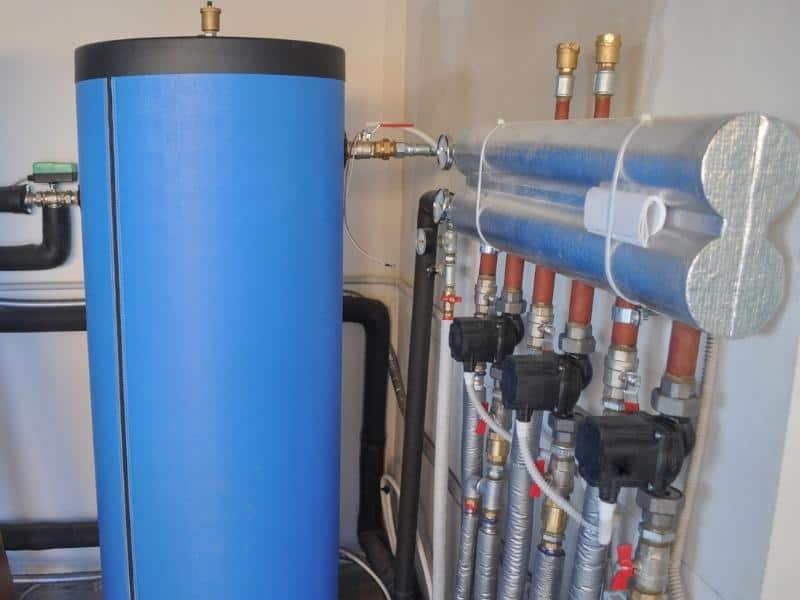Geothermal energy is constantly positioned as a renewable energy also-ran – a technology that looks permanently stuck at the edge of a breakthrough. Yet, proponents swear by its potential, and the burgeoning investment that keeps pouring into the sector creates confusion about geothermal pros and cons.
Geothermal energy has the advantages that stem from its being a clean, low-impact source of renewable energy. It has an innovation trajectory that increases its scope and lowers its costs. On the other hand, it is not universally deployable and costly to initiate.
In this post we’ll go over:
- Assessing geothermal energy for convenience.
- Environmental impacts of geothermal energy.
- Cost-benefit analysis of geothermal energy.
- Other plusses and minuses of thermal power.
We’ll consider the plusses and minuses following a snapshot overview of what the technology involves.

What Is Geothermal Energy?
Geothermal energy is a set of technologies for extracting subterranean heat for conversion into electrical energy. The first installation was in 1904, and since then, a slow technological shift has happened to broaden its application.
The earth’s outermost layer consists of plates. Continental drift is the process by which these plates push against and drift away from each other.
Gaps between adjacent plates create fissures through which heat from the magma in the earth’s core leaks. Geothermal accesses this energy.
Geothermal Power Plants
Geothermal plants consist of a looped tube that accesses the hot rock near the exposed magma (molten rock) deep below the plates. Liquid flowing through the tube absorbed the heat, transferring it to a boiler at the surface of the plant.
This transfer is where the energy is generated.
Domestic installations target a different terrestrial heat source – radiation from the sun absorbed by the earth. This radiation is similarly accessed by water looped into the warm earth.
The temperatures accessed here are much cooler than in the plants and generate much lower energy volumes.
What Are Geothermal Energy Pros?
Geothermal energy has several advantages that accrue from its status as a renewable energy source. Even within the realm of renewable energy sources, it competes favorably on some performance factors against the more popular solar and wind alternatives.
1. Renewability
Utility-scale geothermal plants access heat derived from deep within the core of the earth. Scientists estimate that these sources will last billions of years. Consequently, deep terrestrial heat should be considered a renewable resource.
Domestic geothermal systems tap solar heat absorbed by the earth. This heat sink is a reservoir that accounts for 80% of solar radiation. For this reason, small-scale geothermal should also be considered a renewable resource.
At no stage in the production of geothermal at any scale is there a dependence on fuel or catalyst, which is in scarce supply.
Unlike conventional fossil-based energy systems, geothermal can sustain its own consumption rate.
2. Atmospheric Pollution
Generally, geothermal energy is regarded as an environmentally friendly source. According to the EIA, the carbon dioxide released by an average geothermal power plant is 99% less than a coal plant for every megawatt-hour of electricity produced.
The continued development of geothermal resources is expected to aid the fight against climate change. The increased adoption will reduce global carbon emissions.
Geothermal installations generate minimal noise pollution. This level is true for large plants relative to wind farms.
It is relevant in the case of home geothermal, where the effects of noise pollution are acute. Heat pumps and their associated infrastructure are silent.
3. Untapped Potential
Presently, geothermal power plants deliver 12.7GW of the 17TW generated by all sources – fossil and renewables alike. That’s less than 0.08% of total demand.
What puts the figure into proper perspective is that while we’re at peak oil, the heat below the surface of the earth is virtually boundless.
This combination of vast untapped reserves and low adoption means that the market for geothermal has massive potential. On the back of that, price inflation should be at worst modest.
A likely expectation is that the consumer price of geothermal should drop as more capacity is brought onstream by increasingly efficient technology.
4. Sustainability And Stability (Reliability)
Geothermal is sustainable and stable. Jointly these make it a reliable source of energy.
Unlike the wind, which varies wildly in intensity, and sunlight which is often obscured by heavy cloud, subterranean heat is always on. And its level of intensity stays within a known narrow range.
This lack of intermittence obviates the need for storage. Geothermal plants have access to a source that guarantees a consistent power output regardless of prevailing atmospheric conditions.
Stability allows more accurate resource planning for consumers of energy. Baseload energy demand can be met with minimal risk of disruption.
5. Operating Cost
Because geothermal systems contain only very few movable parts, all of which are either sheltered inside a building or snuggly underground, the life span of these systems is relatively high.
This is reflected in the warranties of heat pumps, which range between twenty-five and fifty years.
The plants have low, predictable operating costs, as they are highly labor efficient.
6. Innovation
Because the geothermal industry has not yet reached maturation, its technology is still in a state of evolution. This means that most breakthroughs in the field lie ahead, and with that, the potential to achieve cost reductions and efficiencies.
Advances in Enhanced Geothermal Systems have made deeper drilling possible. The key has been high-speed fracturing technologies that maximize the extraction of deeply embedded heat and steam.
Hot Dry Rock technology has made previously untenable rock deposits mineable, removing the need for subterranean water sources.
New techniques for artificial fracturing and liquid injection at depth have opened a previously foreclosed abundant source of energy.
7. Scalability
At the level of utility-level geothermal, plants can be scaled up and down by installing and disabling capacity. This creates some flexibility in the plant design.
Geothermal is scalable at a higher level, as it can be implemented in local grids down to the level of individual homes. Geothermal heat pumps for the home exploit abundant low-temperature reservoirs.
Closed and open-loops systems take advantage of natural ground heating by the sun to extract subterranean energy for home use.
The local grids between utility and home scale can be set up to power individual industrial projects, farms, and even small communities.
8. Footprint
Geothermal has a vertical topology – a bent pipe is sent down into the ground, accessing heat at depth. Because the distance is traveled into the earth’s crust, it requires less surface area.
Compare that situation to wind and solar farms where the catchment is entirely horizontal, with no utilization of the unused space below the earth’s surface.
A National Geographic estimate calculates that geothermal requires 88% less space to mine a gigawatt of energy than wind and solar.
The narrow footprint minimizes the chance of disturbing human settlements or competing for arable agricultural space. It minimally intrudes on the aesthetics of the surrounding land.
9. Longevity
The US Department of Energy calculates that heat pumps have an expected life of twenty years. By the same estimate, the underground infrastructure for home geothermal has is fifty years.
The longevity should be considered in light of replacement costs over that span of time. There is a long lead time to provide for capital replacement off a fraction of the revenues. This places replacement costs in a lower expense bracket than the upfront costs (see under Cons below).
Further to the remarks on sustainability, the resource itself will not outlive the infrastructure in the case of home geothermal systems.
10. Heating And Cooling
In order to rotate the turbines for power generation efficiently, electrical generation with geothermal requires high water temperatures – reaching beyond 300F.
A way around this is to focus on the heat differential between the earth’s surface and a ground source. This approach is involved when geothermal is used for heating and cooling.
Because the earth has much less variance than the air, shallow ground only feet below the surface can support a heat source or sink with a geothermal heat pump. This is analogous to the extraction of atmospheric heat by an electric heat pump.
On the back of this application, a large number of homeowners have fuelled the growth in geothermal heater/coolers.
11. Efficiency
The pumps used in home geothermal use 25-50% less electricity than conventional systems used to cool and heat buildings. They are adjustable so that their performance can be regulated for different conditions.
This takes away the need for space, as regulators are conventionally employed to effect these adjustments.
To transfer five units of cooling or heating, geothermal pumps require one unit of electricity. This is up to a quarter as much as a conventional pump. In extreme temperatures, their efficiency rates are at 300-600%, in comparison with air-source heat pumps that come in at 175-250%.
The factor increase in efficiency over fossil fuel furnaces is 3.5-5 times.
What Are Geothermal Energy Cons?
On the credit side of the geothermal balance sheet is a range of factors that explain why – in spite of the pros listed above – this energy source has struggled to assert itself as a competitive alternative over its rivals.
Fans of geothermal (this author included) hope that momentum lives on the side of the plusses, but a sober assessment must have regard for the considerations listed below.
1. Location Restriction
Until magma mining becomes, low-cost geothermal mines can be built only in a limited number of locales. Most large-scale plants require reservoirs above 212F.
These are found only in specific places. Usually, these locales lie at tectonic plate boundaries where magma is naturally exposed.
For this reason, US geothermal plants lie largely in California, close to the Pacific “ring of fire.” The lower-temperate resources in the rest of the union are below the required threshold for feasible geothermal mining.
Hydrothermal plants require proximity to hot springs, which further limits the minable sites. Hot, dry rock expands the mineable surface area, but this is dependent on natural deposits of rare hot minerals and gases.
2. Greenhouse Emissions
As noted under pros, geothermal does not involve the emission of carbon – or other greenhouse gasses – during the energy generation phase. This is a direct consequence of no fossil fuels being burnt during the generation process.
That would be the end of the story, except that there is concern about subterranean noxious gasses that are released. These typically remain lodged safely in the earth’s remote core. The fracturing that opens access to deeply embedded heat releases those gases, emitting them into the atmosphere.
The anthropogenic cause of these emissions has been established by the correlation of their concentration with the location of geothermal plants.
The level of emissions compares favorably with the fossil alternatives in use today, but the volumes should increase as existing paths widen and new installations introduce fresh fractures.
3. Earthquakes
The link between large-scale geothermal and increased incidence of earthquakes is under investigation in the light of seismic activity in the Geysers region of California.
This area has a natural tendency to quake, but the incidence has increased following the growth of geothermal plants in the area.
Seismologists have attributed this to the extraction of heat and steam contacting the rock. This shrinkage creates a buildup of contractual stress, which can lead to quakes.
This is exacerbated by the injection of cold water into the hot, dry rock, leading to a thermal contrast which is a known contributor to earthquakes.
It is also theorized that high-pressure leakage makes its way into faults, exacerbating seismic fault lines.
4. Depletion Risk
The geothermal reserve is virtually inexhaustible. Practically this reserve is accessible by fracturing the earth. As discussed above (“earthquakes”), this fracturing is implicated in the weakening of the ground.
This weakening places a time constraint on access to geothermal. The depletable resource is not the ground heat but the fragile terrain through which it needs to be accessed.
Susceptibility varies by site. Those with shallower heat deposits are more prone to depletion risk as ground contraction closer to the surface is harder to mitigate.
5. Investment Cost
While large-scale geothermal plants are generally ROI-positive, the returns accrue at the end of their very long lives. This leaves a huge initial investment which makes their build prohibitive.
Compared with utility-scale wind and solar, which have maximum upfront outlays of $1,550/kWh and $1,250/kWh, geothermal plants require $6,000/kWh. Combined cycle gas plants are as much as a quarter the upfront cost of geothermal.
These upfront costs are attributable to the drilling costs associated with tunneling hundreds of yards into the earth’s crust.
The bad news is that the evolving technologies of magma and hot, dry rock require deep drilling.
6. Sustainability
Low-temperature enhanced geothermal systems (EGS) have broadened the span of mineable terrain, bringing low-temperature ground into play. Building these plants involves a large expenditure of material and energy, raising the question of what the environmental impact of these plants is over their whole life.
Comprehensive life cycle analysis on low-temperature EGS plants has shown that environmental impacts are correlated with the geological conditions available at the site.
Sites with unfavorable conditions are hemmed by narrow design constraints to offset the material and cost input. These constraints require enhancement of the efficiency of the reservoir productivity, good deep design, and efficient use of the geothermal fluid.
Failure to manage this constraint at the design level leads to plants that fail on a cradle-to-grave basis to sustain their consumption rates.
7. High Minimum Temperature
Geothermal energy has a high minimum temperature feasibility threshold. This restricts the ground that can be used and places extreme reliance on EGS technology.
The entire continent of Africa, an energy-hungry block with development needs, is situated away from the hot edges of its containing tectonic plate.
References




